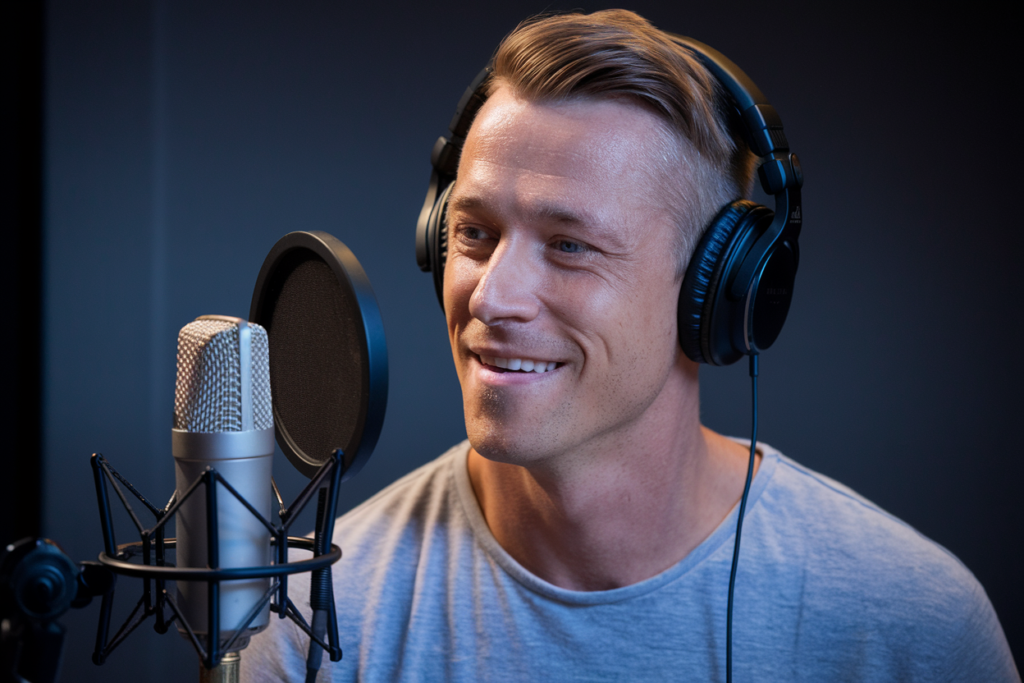Key Takeaways
- Lip Syncing Essentials: Lip syncing is crucial in Australian English dubbing, aligning dialogue with character mouth movements while maintaining cultural authenticity and viewer immersion.
- Challenges of Australian English: Unique phonetics, slang, and regional accents present challenges that require voice actors to adapt their techniques for effective lip syncing.
- Techniques for Success: Mastery of timing, rhythm, and phonetic matching enhances the quality of dubbing performances, making them more engaging and relatable to local audiences.
- Tools and Software Utilization: Advanced tools like Adobe Audition and Pro Tools are essential for achieving high-quality audio synchronization in dubbing projects.
- Learning from Case Studies: Successful projects demonstrate the importance of cultural nuances, while failures emphasize the need for accurate alignment between audio delivery and visual cues.
- Future Trends: Innovations in technology, increasing demand for authentic local accents, collaboration among artists, remote recording capabilities, and sustainable practices are shaping the future of lip syncing in Australian English dubbing.
Ever wondered how your favorite shows sound so natural in Australian English? Lip syncing for Australian English dubbing plays a crucial role in making that happen. It’s not just about matching words to mouths; it’s about capturing the essence of Aussie culture and language nuances.
Overview of Lip Syncing
Lip syncing plays a crucial role in Australian English dubbing, ensuring that dialogue aligns seamlessly with character mouth movements. This process requires a delicate balance between technical precision and cultural authenticity.
Importance in Dubbing
Lip syncing is essential for maintaining viewer immersion. When the audio matches the visual cues, audiences connect more deeply with the characters and storyline. Voice artists must not only replicate the original script but also capture local dialects, expressions, and emotions that resonate with Australian viewers. Achieving this level of authenticity enhances overall production quality and keeps your audience engaged.
Challenges in Australian English
Australian English presents unique challenges for lip syncing due to its distinctive phonetics and slang. For instance, vowel sounds differ significantly from other English variations, impacting how voice actors articulate words during dubbing. Additionally, capturing regional accents or colloquialisms involves extensive research and practice by voice talent to ensure believable performances. The combination of these factors can complicate synchronization efforts while requiring voice over artists to adapt their techniques accordingly.
Techniques for Effective Lip Syncing
Lip syncing in Australian English dubbing involves several techniques that ensure voice performances align with animated visuals seamlessly. Focusing on timing, rhythm, and phonetic matching enhances overall authenticity.
Timing and Rhythm
Timing plays a crucial role in effective lip syncing. You need to synchronize dialogue delivery with the character’s mouth movements precisely. This requires understanding the pacing of the original performance and adjusting your timing accordingly. Voice artists often practice alongside video clips to capture the flow of speech accurately. By doing so, you can develop a keen sense of rhythm that matches both the visual cues and emotional undertones of each scene.
Phonetic Matching
Phonetic matching is vital for achieving an authentic sound in Australian English dubbing. It involves aligning your voice’s pronunciation with character mouth shapes during dialogue delivery. Familiarizing yourself with local slang, intonation patterns, and vowel sounds improves this alignment significantly. As a voice actor, you’ll want to research common phrases used in everyday conversations within various Australian regions. Doing this ensures your performance resonates with local audiences while maintaining cultural nuances vital for immersion.
By mastering these techniques—timing, rhythm, and phonetic matching—you enhance your lip syncing abilities significantly, ensuring an engaging experience for viewers while showcasing your skills as a voice artist or actor.
Tools and Software for Dubbing
Dubbing requires a range of tools and software to ensure voice performances sync flawlessly with visuals. The right technology enhances the quality of your production, making it essential for both voice artists and producers.
Popular Dubbing Tools
- Adobe Audition: This powerful audio editing software allows you to fine-tune recordings, adjust levels, and apply effects that enhance vocal performances.
- Pro Tools: Widely used in the industry, Pro Tools offers advanced capabilities for mixing, editing, and recording high-quality audio tracks.
- Final Cut Pro: While primarily a video editing tool, Final Cut Pro provides excellent options for syncing audio with video clips effectively.
- Avid Media Composer: This comprehensive tool combines video and audio editing features ideal for dubbing projects requiring intricate synchronization.
- iZotope RX: Best known for its restoration capabilities, iZotope RX helps clean up any unwanted noise from recordings, ensuring pristine sound quality.
Software Features
- Multi-Track Editing: Many dubbing software programs support multi-track editing so you can layer different voiceovers over visual content seamlessly.
- Time Stretching: This feature allows you to stretch or compress audio without altering pitch, facilitating better alignment with mouth movements.
- Pitch Correction: Useful for maintaining vocal consistency across different takes or sessions while ensuring your voice artist’s delivery sounds natural.
- Spectral Editing: Helps visualize sound frequencies to isolate specific sounds or words needing adjustment during the dubbing process.
- Real-Time Monitoring: Enables voice actors to hear their performance live as they record, allowing immediate adjustments if something doesn’t feel right.
Investing in reliable tools and leveraging effective software features significantly impacts your dubbing project’s success. With the right resources at hand, you’ll find it easier to achieve professional results that resonate with audiences while showcasing talented voice artists’ skills effectively.
Case Studies
Exploring successful case studies highlights the effectiveness of lip syncing in Australian English dubbing. This section examines notable projects and lessons learned from both successes and failures, offering insights that can benefit future endeavors.
Successful Australian English Dubbing Projects
Successful dubbing projects showcase the importance of cultural authenticity and technical precision. For instance, animated series like Bluey have gained immense popularity due to their relatable characters and local dialects. The voice actors captured the essence of Australian life, using familiar expressions and intonations that resonate with viewers. Their ability to align dialogue seamlessly with character mouth movements enhanced viewer immersion, making the experience feel natural.
Another example is live-action films adapted for an Australian audience. Using skilled voice talent ensures that emotional nuances translate effectively across cultures. When voice artists replicate original performances while infusing local flavor, they create a connection with audiences that elevates storytelling.
Lessons Learned from Failed Dubs
Failed dubs serve as valuable learning opportunities in the industry. One common issue arises when voiceovers fail to match character mouth movements accurately, leading to a disjointed viewing experience. Misalignment between audio delivery and visual cues can distract viewers, undermining emotional engagement.
Additionally, neglecting local slang or cultural references often results in a disconnect with audiences. Voice actors must immerse themselves in regional dialects to avoid losing authenticity. Cases where this hasn’t been prioritized show how crucial it is for artists to adapt their performances based on extensive research into local customs and language use.
These examples illustrate how understanding both successes and failures shapes effective lip syncing strategies in Australian English dubbing, ensuring future projects resonate deeply with viewers while enhancing overall production quality.
Future Trends in Lip Syncing for Australian English
The landscape of lip syncing for Australian English is evolving rapidly. As technology advances, voice artists increasingly integrate cutting-edge tools to enhance their dubbing efforts. Innovations like artificial intelligence and machine learning play significant roles, improving the efficiency of synchronization processes.
Voice talent will likely see a rise in demand for authentic accents and local dialects. As audiences crave relatable content, productions that prioritize cultural nuances resonate more deeply with viewers. This trend emphasizes the importance of hiring skilled voice actors who can deliver genuine performances that reflect Australian vernacular.
Collaboration among voice over artists is also becoming more common. By sharing techniques and insights, professionals can elevate their craft collectively. This collaborative spirit fosters an environment where creativity thrives, resulting in higher-quality productions.
Moreover, remote recording technologies are transforming how voiceovers are produced. With cloud-based solutions, voice actors can work from virtually anywhere while maintaining high audio standards. This flexibility allows access to a broader pool of talent without geographical constraints.
Sustainability practices are gaining traction too. The industry recognizes the need for environmentally friendly production methods as awareness grows around climate issues. Voiceover projects that adopt green practices not only appeal to eco-conscious clients but also contribute positively to community perceptions.
As viewer preferences shift toward immersive experiences, lip syncing must adapt accordingly. Expect future projects to incorporate interactive elements where viewers engage directly with characters or storylines through enhanced audio-visual sync techniques.
Embracing these trends positions you at the forefront of effective lip syncing strategies in Australian English dubbing. Prioritizing local culture and technological advancements ensures your projects remain relevant and captivating for audiences today and into the future.
Conclusion
Mastering lip syncing for Australian English dubbing is essential for creating authentic and engaging content. By focusing on cultural nuances and technical precision, you can elevate the viewing experience and foster a deeper connection between audiences and characters.
As technology continues to advance, staying updated with the latest tools and techniques will enhance your dubbing projects. Embracing collaboration among voice artists also opens doors to creativity and innovation in this evolving landscape.
With an eye toward future trends, adapting your approach will ensure that your work resonates with viewers now and in years to come. The journey of perfecting lip syncing is not just about matching words but crafting a genuine reflection of Australian culture through sound.
Frequently Asked Questions
What is the significance of lip syncing in Australian English dubbing?
Lip syncing in Australian English dubbing is crucial for aligning dialogue with character mouth movements while capturing local culture and language nuances. It enhances viewer immersion, allowing audiences to connect more deeply with characters and their stories.
How do voice artists ensure effective lip syncing?
Voice artists achieve effective lip syncing by mastering techniques such as timing, rhythm, and phonetic matching. They practice synchronizing dialogue delivery with visual cues and familiarize themselves with local slang and intonation patterns for authenticity.
What tools are essential for dubbing projects?
Key tools for dubbing include software like Adobe Audition, Pro Tools, Final Cut Pro, Avid Media Composer, and iZotope RX. These programs offer features like multi-track editing and pitch correction that enhance synchronization quality in voice performances.
Can you give an example of successful Australian English dubbing?
The animated series “Bluey” is a prime example of successful Australian English dubbing. Its relatable characters and use of local dialects resonate well with audiences, showcasing the importance of cultural authenticity in engaging viewers.
What challenges do voice artists face when lip syncing?
Voice artists encounter challenges such as aligning audio perfectly with visual cues while navigating unique aspects of Australian English phonetics and slang. This requires extensive research and practice to maintain accuracy in synchronization efforts.
How is technology changing the landscape of lip syncing?
Technological advancements like artificial intelligence are improving efficiency in synchronization processes. Additionally, remote recording technologies allow voice talent to work from various locations while maintaining high audio quality standards.
What future trends are expected in Australian English dubbing?
Future trends include a focus on authentic accents due to audience demand for relatable content, collaboration among voice artists for creativity enhancement, and incorporating interactive elements into projects to deepen viewer engagement experiences.







